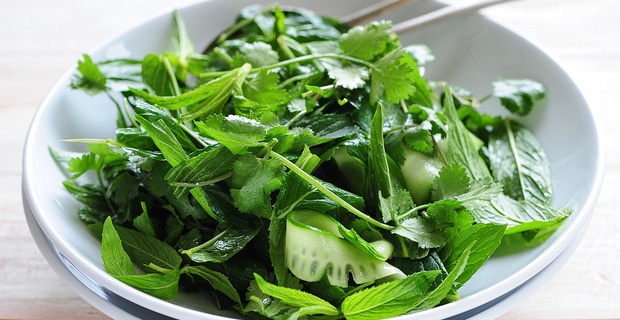
If you eat by the seasons, and you live somewhere not in, say, Southern California, then you may have been consuming a lot of kale, potatoes and winter squash since last fall. But now that the thermometer is making its slow climb to warmer temperatures and the days are getting longer, spring produce is making its debut. Shimmying up through the soil are the bright young tender things that make the wait so worthwhile. Although many spring vegetables are available year round, spring greens are at their best right now. Here are five not to miss.
1. Arugula
Also known as rocket, arugula is the unique peppery salad green of which Virgil praised in the poem, Moretum: et veneris revocans eruca morantuem – which translates to “the rocket excites the sexual desire of drowsy people.” Long hailed as an aphrodisiac, apocryphal or not, arugula is bursting with bright flavor and wonderful nutrients. It is high in vitamins A and K, and folic acid, as well as a good source of zinc, potassium, calcium and iron. And it’s wildly versatile. Try it mixed into salad greens or as the base of a salad with lemon, olive oil, and shaved Parmesan. Top a pizza with it, use it in a sandwich, toss it into pasta, or use it to make pesto.
2. Dandelion
Some look at a lawn full of dandelions and see pesky weeds; others see…free food! Dandelion flowers and their greens have been eaten in Europe for centuries and have a long list of curative effects attributed to them. Flowers can be used in wine and syrup; the greens are bitter but in a lovely, addictive way. Young dandelion greens are tender and fabulous served raw in salads, sandwiches, and green smoothies. If you use greens that have been harvested after the plant has flowered, they will have increased bitterness; but it’s not a deal breaker. Blanch them first, make cream of dandelion soup, or sauté them with strong complimentary flavors like fruity olive oil along with a load of garlic and red pepper flakes.
3. Parsley
Parsley’s continuous presence on the side of every dinner dish ever served has done nothing for its reputation; it’s generally seen as little more than a disposable piece of greenery whose total purpose in life is to add color to a pallid plate of food. But the little herb that could has so much to offer. In addition to being an excellent source of vitamins A, C and K and a good source of iron and folate, it is rich in volatile oils and flavonoids; and when used as a major component of a dish, rather than a garnish, it is as delicious as it is surprising. Play around with parsley using it as a green rather than an herb, for starters, try making a parsley-based pesto or a parsley-full tabouli.
4. Pea Greens/Shoots
Along with the peas grow their greens – the tender tendrils and shoots that support the peas themselves. Fortunately, farmers have found that there is a market for them and thus they are increasingly available along with peas. They are light, sweet, tender, and nutritious. Pea greens are delicate, the princesses of the vegetable world, and are best handled with a gentle touch. Add them to salads, sandwiches, lightly sauté them with garlic or put them on top of just about everything for a sweet, snappy garnish. As most greens, they are also a good candidate for pesto.
5. Ramps
If ramps, also known as wild leeks, are available, you know it’s spring. They have a relatively short growing period, about six weeks, and are thus consumed with manic reverence by ramp lovers wherever they grow. They are wild and most often available in specialty stores or farmers markets (or in the woods behind your house, should you be so lucky). The ramp is a lovely to behold, but packs a punch – a one-two of onion and garlic; they are pungent greens not for the weak of heart. Use them as you would onions or leeks; sautéed with whole wheat pasta is perhaps their most common employment, but try them on pizza, in risotto, as a soup vegetable, in pesto, or scrambled with eggs. But get them while you can, although their flavor has staying power, their season is fleeting.
Image: jules




